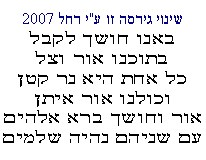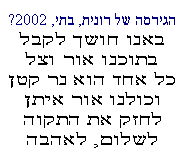|
An example of
Learning
on the mental level:
How
does a Laser work?
The "Laser"-beam is
my metaphor
for how I,
one seemingly insignificant individual,
can create
Heaven-on-Earth.
"The Basics of an Atom
There are only about 100 different kinds of atoms in the entire universe.
Everything we see is made up of these 100 atoms in an unlimited number
of combinations.
How these atoms are arranged and bonded together
determines whether the atoms make up a cup of water, a piece of metal,
..
Atoms are constantly in motion.
They continuously vibrate, move and rotate.
Even the atoms that make up the chairs that we sit in are moving around.
Solids are actually in motion!
Atoms can be in different states of excitation.
In other words, they can have different energies.
If we apply a lot of energy to an atom,
it can leave what is called the ground-state energy level and go to
an excited level.
The level of excitation depends on the amount of energy that is applied
to the atom
via heat, light, or electricity.
Here is a classic interpretation of what the atom looks like:
An atom, in the simplest model,
consists of a nucleus and orbiting electrons.
This simple atom consists of a nucleus (containing the protons and neutrons)
and an electron cloud.
It’s helpful to think of the electrons in this cloud
circling the nucleus in many different orbits
"Absorbing
Energy
Although more modern views of the atom
do not depict discrete orbits for the electrons,
it can be useful to think of these orbits as the different energy levels
of the atom.
In other words, if we apply some heat to an atom,
we might expect
that some of the electrons in the lower-energy orbits
would transition to higher-energy orbits farther away from the nucleus.
"Absorption of energy:
An atom absorbs energy
in the form of heat, light, or electricity.
Electrons may move from a lower-energy orbit
to a higher-energy orbit.
This is a highly simplified view of things,
but it actually reflects the core idea of how atoms work in terms of
lasers.
Once an electron moves to a higher-energy orbit,
it eventually wants to return to the ground state.
When it does, it releases its energy as a photon -- a particle of light.
You see atoms releasing energy as photons all the time.
For example, when the heating element in a toaster turns bright red,
the red color is caused by atoms, excited by heat, releasing red photons.
When you see a picture on a TV screen,
what you are seeing is phosphor atoms,
excited by high-speed electrons, emitting different colors of light.
Anything that produces light -- fluorescent lights, gas lanterns, incandescent
bulbs --
does it through the action of electrons changing orbits and releasing
photons.
"The
Laser/Atom Connection
A laser is a device that controls the way
that energized atoms release photons.
"Laser" is an acronym for
light amplification by stimulated emission of radiation,
which describes very succinctly how a laser works.
Although there are many types of lasers, all have certain essential
features.
In a laser,
the lasing medium is “pumped”
to get the atoms into an excited state.
Typically, very intense flashes of light
or electrical discharges
pump the lasing medium
and create a large collection of excited-state atoms
(atoms with higher-energy electrons).
It is necessary to have a large collection of atoms in the excited state
for the laser to work efficiently.
In general, the atoms are excited to a level
that is two or three levels above the ground state.
This increases the degree of population inversion.
The population inversion is the number of atoms in the excited state
versus the number in ground state.
Once the lasing medium is pumped,
it contains a collection of atoms with some electrons sitting in excited
levels. The excited electrons have energies greater than the more relaxed
electrons. Just as the electron absorbed some amount of energy
to reach this excited level,
it can also release this energy.
As the figure below illustrates,
the electron can simply relax,
and in turn rid itself of some energy.
This emitted energy comes in the form of photons (light energy).
The photon emitted has a very specific wavelength (color)
that depends on the state of the electron's energy when the photon is
released.
Two identical atoms
with electrons in identical states
will release photons with identical wavelengths.
"Laser Light
Laser light is very different from normal light.
Laser light has the following properties:
• The light released is monochromatic.
It contains one specific wavelength of light
(one specific color).
The wavelength of light is determined
by the amount of energy released
when the electron drops to a lower orbit.
• The light released is coherent.
It is “organized” -- each photon moves
in step with the others.
This means that all of the photons have wave fronts
that launch in unison.
• The light is very directional.
A laser light has a very tight beam
and is very strong and concentrated.
A flashlight, on the other hand, releases light in many directions,
and the light is very weak and diffuse.
To make these three properties occur takes something called stimulated
emission.
This does not occur in your ordinary flashlight --
in a flashlight, all of the atoms release their photons randomly.
In stimulated emission, photon emission is organized.
"The photon that any atom releases has a certain
wavelength
that is dependent on the energy difference
between the excited state and the ground state.
If this photon (possessing a certain energy and phase)
should encounter another atom
that has an electron in the same excited state,
stimulated emission can occur.
The first photon can stimulate or induce atomic emission
such that the subsequent emitted photon (from the second atom) vibrates
with the same frequency and direction
as the incoming photon.
The other key to a laser is a pair of mirrors,
one at each end of the lasing medium.
Photons, with a very specific wavelength and phase,
reflect off the mirrors
to travel back and forth through the lasing medium.
In the process, they stimulate other electrons
to make the downward energy jump
and can cause the emission
of more photons of the same wavelength and phase.
A cascade effect occurs,
and soon we have propagated many, many photons
of the same wavelength and phase.
The mirror at one end of the laser is "half-silvered,"
meaning it reflects some light and lets some light through.
The light that makes it through is the laser light.
You can see all of these components in the figures on the following
page,
which illustrate how a simple ruby laser works.
"Ruby Lasers
A ruby laser consists of a flash tube (like you would have on a camera),
a ruby rod and two mirrors (one half-silvered).
The ruby rod is the lasing medium and the flash tube pumps it.
1. The laser in its non-lasing state
2. The flash tube fires and injects light into the ruby rod.
The light excites atoms in the ruby.
3. Some of these atoms emit photons.
4. Some of these photons run in a direction parallel to the ruby's axis,
so they bounce back and forth off the mirrors.
As they pass through the crystal, they stimulate emission in other atoms.
5. Monochromatic, single-phase, columnated light
leaves the ruby through the half-silvered mirror -- laser light!
"Three-Level
Laser
Here's what happens in a real-life, three-level laser.
"Types of
Lasers
There are many different types of lasers.
The laser medium can be a solid, gas, liquid or semiconductor
. Lasers are commonly designated by the type of lasing material employed:
• Solid-state lasers have lasing material distributed in a solid
matrix
(such as the ruby or neodymium:yttrium-aluminum garnet "Yag"
lasers).
The neodymium-Yag laser emits infrared light at 1,064 nanometers (nm).
A nanometer is 1x10-9 meters.
• Gas lasers (helium and helium-neon, HeNe, are the most common
gas lasers)
have a primary output of visible red light.
CO2 lasers emit energy in the far-infrared, and are used for cutting
hard materials.
• Excimer lasers (the name is derived from the terms excited and
dimers)
use reactive gases, such as chlorine and fluorine,
mixed with inert gases such as argon, krypton or xenon.
When electrically stimulated, a pseudo molecule (dimer) is produced.
When lased, the dimer produces light in the ultraviolet range.
• Dye lasers use complex organic dyes, such as rhodamine 6G,
in liquid solution or suspension as lasing media.
They are tunable over a broad range of wavelengths.
• Semiconductor lasers, sometimes called diode lasers,
are not solid-state lasers.
These electronic devices are generally very small and use low power.
They may be built into larger arrays,
such as the writing source in some laser printers or CD players.
"What's Your
Wavelength?
A ruby laser (depicted earlier) is a solid-state laser
and emits at a wavelength of 694 nm.
Other lasing mediums can be selected based on the desired emission wavelength
(see table below), power needed, and pulse duration.
Some lasers are very powerful, such as the CO2 laser, which can cut
through steel. The reason that the CO2 laser is so dangerous is
because it emits laser light in the infrared and microwave region of
the spectrum. Infrared radiation is heat,
and this laser basically melts through whatever it is focused upon.
Other lasers, such as diode lasers, are very weak
and are used in today’s pocket laser pointers.
These lasers typically emit a red beam of light
that has a wavelength between 630 nm and 680 nm.
Lasers are utilized in industry and research to do many things,
including using intense laser light to excite other molecules
to observe what happens to them.
Here are some typical lasers and their emission wavelengths:
Laser Type Wavelength (nm)
Argon fluoride (UV) 193
Krypton fluoride (UV) 248
Xenon chloride (UV) 308
Nitrogen (UV) 337
Argon (blue) 488
Argon (green) 514
Helium neon (green) 543
Helium neon (red) 633
Rhodamine 6G dye (tunable) 570-650
Ruby (CrAlO3) (red) 694
Nd:Yag (NIR) 1064
Carbon dioxide (FIR) 10600
|
Diary, December 5,
first day of Chanuka



Diary, December 6, second day of Chanuka



Diary, December 7, third day of Chanuka






Diary, December 8, fourth day of Chanuka
 









|
![]()




 to next
sculpture of my Present
to next
sculpture of my Present






















